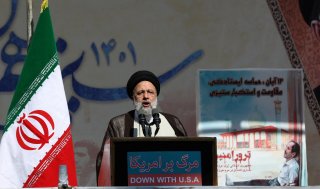Is Iran’s Theocracy on the Chopping Block?
Even if the mullahs and their enforcers can prevail for now, history teaches that force alone cannot guarantee the regime’s survival, let alone legitimacy.
The ongoing social unrest in Iran sparked by the death of Mahsa Amini, a young Kurdish woman murdered by the Islamic Republic’s “morality police,” shows no sign of abetting. Naturally, legions of Iran watchers have offered speculation on the endgame of the upheaval. Scenarios have ranged from the emergence of democracy to the upholding of the status quo or an emboldened theocracy turning into a totalitarian state run by the Islamic Revolutionary Guard Corps (IRGC). Revolutions are inherently difficult to predict, but some observations on the progress of the struggle can be offered.
First, with the exception of the 2009 uprising over the stolen election, the current turmoil is uniquely broad-based, with protests supported across all ethnic groups and provinces. This so-called “global Iran,” a collective of people with diverse ethnic identities separated by geography, is “very much together in feelings, in concerns, and in dreams,” as scholar Asef Bayat wrote.
Second, the unrest is powered by strong economic undercurrents, creating a virtual Bermuda Triangle for the embattled regime. After years of crippling sanctions, extravagant spending on its proxies in the “Axis of Resistance,” and monumental corruption and mismanagement, the economy is in shambles. Amid the protests, the rial has dropped to a record low and food prices have jumped by more than 82 percent.
Workers across key industries—including oil and gas, steel, and food production—went on strike. Pensioners have protested because their payments cannot keep up with rampant inflation and the massive increase in the price of food. Recent embezzlement scandals in some pension funds added to the disarray and brought more protesters to the streets.
Third, should the nascent strike movement grow, it would likely tip the scales against the regime. To recall, in 1978, a general strike—which also included the powerful bazaaris, the merchants who operate stores in the bazaars—limited the shah’s options. Several observers have suggested that a general strike is not in the cards because the workers do not exhibit the type of unity that prevailed in 1978. This conclusion may be premature, however, as the Free Union of Iranian Workers (FUIW) is fast becoming a major force in the unrest. The FUIW is part of the Front-Line Defenders, an international organization that combines advocacy for civil rights with the protection of labor. The FUIW’s impact is already considerable. The Council for Organizing Protests of Oil Contract Workers threatened to strike. The bazaaris, once a reliable constituency for the clergy, stated that they would padlock their businesses because of the shrinking value of the rial.
Of course, the regime is not without powerful tools to subdue the revolutionary forces. As in the past, the application of brute force is the first line of defense. As part of the Ministry of Interior, the Law Enforcement Forces (LEF) has designed special units for crowd control and suppression, known as the Iranian Police Special Units (IPSU). The Special Units, which are present in every province and larger towns, use live ammunition to subdue protesters. The current head of the Special Units, Brig. Gen. Hassan Karami, was sanctioned by the European Union for his role in the violent suppression of previous protests. The brutal Basij, a division within the IRGC, has also been involved in suppressing the demonstrations. Shia proxies such as Hezbollah and the Iraqi Popular Mobilization Forces have also been deployed.
Moreover, the authorities have a wide array of intelligence and monitoring systems at their disposal. The Ministry of Intelligence and Security, the IRGC’s dreaded Intelligence Unit, and LEF’s Cyber Unit have combined their forces to track, trap, and arrest protesters and their leaders. Not incidentally, Iran has been buying public surveillance systems from China for years. So far, Chinese platforms, including 19 million cameras, have been installed in twenty-eight Iranian provinces, with a special emphasis on urban settings. The arch-conservative judiciary system has also stepped up to the plate, recently announcing that more than 1,000 protesters would go on trial in what may be a repeat of the show trials of the early revolutionary days.
In the past, the regime has tried to mix brutal force with material concessions. For instance, during the 2018 gasoline riots, which were prompted by a decision to increase gas prices, the government allowed some sixty liters of subsidized fuel for a broad category of drivers. In 2019, when protests erupted over high food prices, the government subsidized free food rations.
The situation today is very different. On the one hand, the regime cannot compromise on the protesters' core demand: making the hijab voluntary rather than mandatory. As the head of the Supreme Council of the Cultural Revolution, President Ebrahim Raisi obliged the council to enforce the hijab and chastity law with full force. The supreme leader is equally adamant about upholding the hijab as a pillar of the faith, and so is the all-important judiciary. On the other hand, the government cannot improve the economic situation without reaching a new oil deal, an unlikely event given Tehran’s determination to proceed with its nuclear project. The regime is also unlikely to reduce its support for its Axis of Resistance proxies, another sore spot for protesters, who chant, “Neither Gaza, Nor Lebanon, I sacrifice my life for Iran.”
Without compromise, the theocracy will have to rely on increased violence and brutality. Even if the mullahs and their IRGC enforcers can prevail at the moment, history teaches that this force alone cannot guarantee survival, let alone legitimacy.
Farhad Rezaei is a senior research fellow at The Philos Project.
Siavash Gholami is a master’s student in political science at the University of Toronto.
Image: Reuters.

